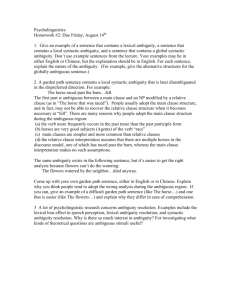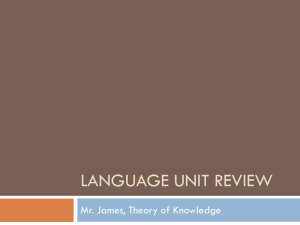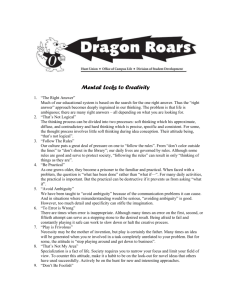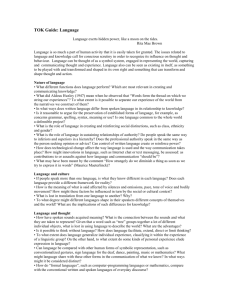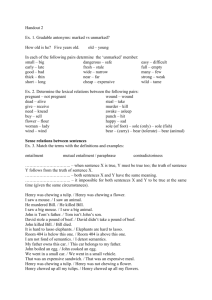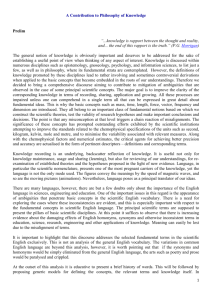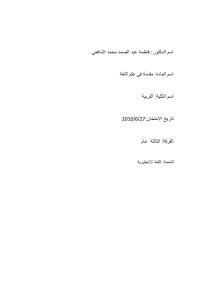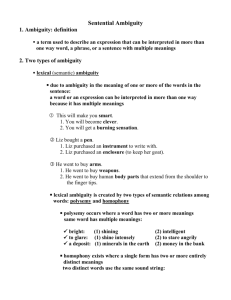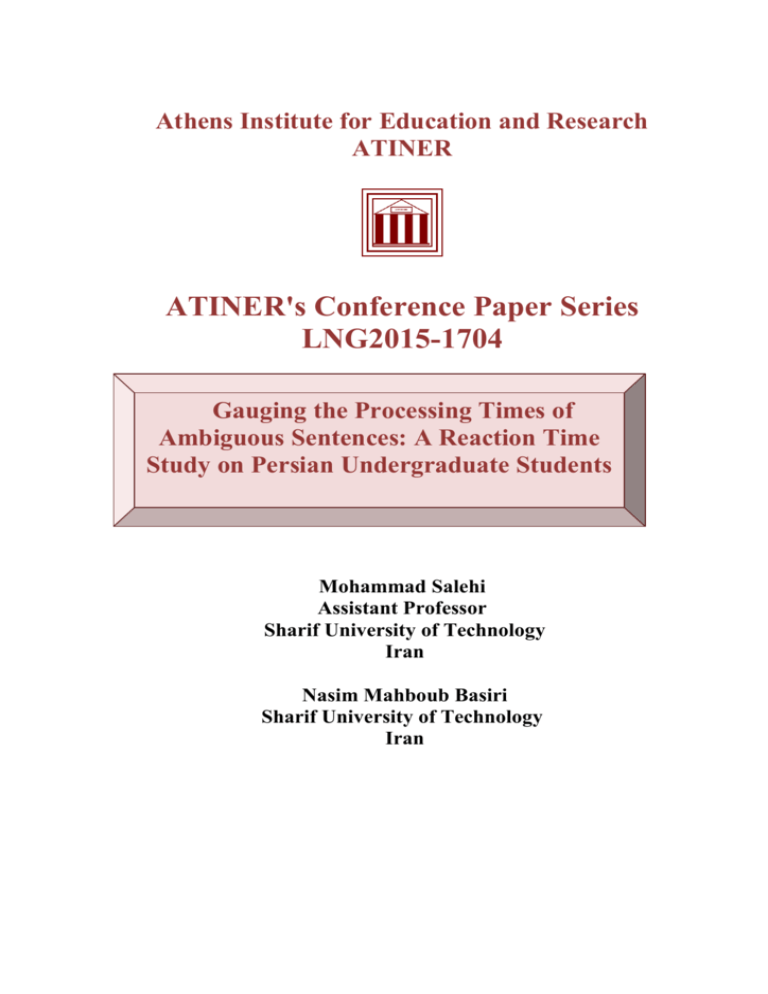
ATINER CONFERENCE PAPER SERIES No: LNG2014-1176
Athens Institute for Education and Research
ATINER
ATINER's Conference Paper Series
LNG2015-1704
Gauging the Processing Times of
Ambiguous Sentences: A Reaction Time
Study on Persian Undergraduate Students
Mohammad Salehi
Assistant Professor
Sharif University of Technology
Iran
Nasim Mahboub Basiri
Sharif University of Technology
Iran
1
ATINER CONFERENCE PAPER SERIES No: LNG2015-1704
An Introduction to
ATINER's Conference Paper Series
ATINER started to publish this conference papers series in 2012. It includes only the
papers submitted for publication after they were presented at one of the conferences
organized by our Institute every year. This paper has been peer reviewed by at least two
academic members of ATINER.
Dr. Gregory T. Papanikos
President
Athens Institute for Education and Research
This paper should be cited as follows:
Salehi, N., and Mahboub Basiri, N. (2015). "Gauging the Processing Times of
Ambiguous Sentences: A Reaction Time Study on Persian Undergraduate
Students", Athens: ATINER'S Conference Paper Series, No: LNG015-1704.
Athens Institute for Education and Research
8 Valaoritou Street, Kolonaki, 10671 Athens, Greece
Tel: + 30 210 3634210 Fax: + 30 210 3634209 Email: info@atiner.gr URL:
www.atiner.gr
URL Conference Papers Series: www.atiner.gr/papers.htm
Printed in Athens, Greece by the Athens Institute for Education and Research. All rights
reserved. Reproduction is allowed for non-commercial purposes if the source is fully
acknowledged.
ISSN: 2241-2891
17/11/2015
ATINER CONFERENCE PAPER SERIES No: LNG2015-1704
Gauging the Processing Times of Ambiguous Sentences:
A Reaction Time Study on Persian Undergraduate Students
Mohammad Salehi
Assistant Professor
Sharif University of Technology
Iran
Nasim Mahboub Basiri
Sharif University of Technology
Iran
Abstract
The present study explored the differences among the process times for
sentences containing one of the three kinds of linguistic ambiguities namely,
lexical, grouping, and functional ambiguities. A reaction time program of a 30item multiple-choice test of translation was developed. Forty-three Persian
undergraduate students took the test. The reaction time of each item was
recorded in milliseconds for each participant. A multivariate ANOVA
(MANOVA) was run to compare the process times for each subsection of the
test. The results of the pair-wise comparison tests indicated that there was a
significant difference between process times for lexical and grouping
ambiguities and between those of lexical and functional ambiguities. There was
no significant difference, however, between the process times for grouping and
functional ambiguities. The findings of this study can be useful in educating
English learners about ambiguities and deciding on which ambiguity should be
under more focus and attention.
Keywords: functional ambiguity, grouping ambiguity, lexical ambiguity,
processing time, reaction time
3
ATINER CONFERENCE PAPER SERIES No: LNG2015-1704
Introduction
Ambiguity is a general term to describe words, phrases, or sentences with
more than one meaning (Fromkin, Rodman, & Hyams, 2013). Linguistic
ambiguity falls into some categories the two most important of which,
according to Hudson (1999), are lexical ambiguity and structural ambiguity,
with the latter one falling into two categories: Grouping ambiguity and
functional ambiguity. Akmajian, Demers, Farmer, and Harnish (2001) define
lexical ambiguity as a situation when a word can have more than one meaning.
For example, in "he picked up a date" the word "date" can be a fruit or a
significant day. According to Hudson (1999), grouping ambiguity is a
subcategory of structural ambiguity in which a sentence has more than one
meaning due to different groupings of the constituents. For instance, in the
phrase, "the brother of Ann and Sarah will go to the party", even though each
word is unambiguous by itself, the whole meaning of the sentence seems to be
ambiguous, as we cannot be sure whether the brother of Ann and Sarah as a
single person is going to the party or if the brother of Ann as well as Sarah are
going to the party. In such cases, it is possible to draw a different tree diagram
for each different grouping. Furthermore, Hudson defines functional ambiguity
as the other subcategory of structural ambiguity arising when some constituents
of the sentence can have different functions, and these different functions cause
different meanings. Take as an example, "John is too far away to see". In this
sentence, John can be either the subject or the object of the sentence, giving
rise to two different meanings. In such cases, it is not possible to draw more
than one tree diagram. According to MacKay (1996), the sentences containing
an ambiguous word are processed slower than unambiguous sentences. There
have been some studies probing the ambiguity processing patterns using
different experimental tasks such as click detection (Garrett, Bever, & Fodor,
1966), self-paced listening (Waters & Caplan, 2004), eye tracking (Kamide,
Altmann, & Haywood, 2003), moving window self-paced reading (Just,
Carpenter, & Woolley, 1982), and maze tasks (Forster, Guerrera, & Elliot,
2009). There seems to be a gap in the literature, however, regarding the use of
one of these tasks to explore the differences among the processing times for
sentences containing one of the three different kinds of the above-mentioned
ambiguities. Accordingly, the current study utilized a reaction time program, a
multiple choice test of translation recording the reaction time on each item, to
investigate the differences between the three mentioned kinds of ambiguities
namely, lexical, grouping, and functional ambiguities, in terms of the time
needed to process a sentence containing one of them.
Literature Review
Processing research is very common in the second language acquisition
research. There have been studies concerning aspects of second language that
were exposed to research. For example, Salehi (2011a) investigated whether
4
ATINER CONFERENCE PAPER SERIES No: LNG2015-1704
the processing of pied-piping and preposition stranding is a function of a
proficiency level of learners. In addition, Salehi and Bagheri (2014)
investigated the effect of the response format on grammaticality judgment.
Processing ambiguous sentences is another promising area for research.
Ambiguity is an inevitable phenomenon in language that can be considered
a functional property of language allowing more efficiency in communication
(Piantadosi, Tily, & Gibson, 2012). At the same time, ambiguity could be a
source of difficulty in processing sentences by readers specifically for those
reading these kinds of sentences in a language other than their first one.
Moreover, it could cause miscommunication especially between native and
non-native speakers of a language. Another ambiguity-related problem worth
mentioning is that of interpreting a grammatical sentence as ungrammatical due
to grouping ambiguity in the so called garden-path sentences (Altmann, 1998).
As MacKay (1996) puts it, sentences containing an ambiguous word are
processed slower than unambiguous sentences. This is true about other kinds of
ambiguities such as grouping and functional ambiguities as well. MacKay and
Gass (2005) consider the reaction time study as a subcategory of processing
research and that measuring the time needed for a sentence to be processed or
to be responded to, usually in milliseconds, is based on the assumption that
sentences with more complex syntax and specifically containing ambiguities,
require more processing time and that "the more time it takes to respond to a
sentence, the more processing "energy" is required" (p. 62). It can therefore be
stated that the processing difficulty that linguistic ambiguities can cause is
generally measured based on the processing time of the sentence containing
that kind of ambiguity. What follows is a brief review of the studies attempting
to measure the processing load of sentences containing different linguistic
ambiguities.
Lexical ambiguity has been the focus of most of the linguistic ambiguityrelated researches. For instance, Simpson (1981) investigated the processing of
ambiguous words via two experiments. In the first experiment, lexical
decisions were made to words related to the dominant or the subordinate
meanings of homograph primes. In the second experiment, however,
ambiguous words ended sentences varying in the degree to which they biased
the dominant or subordinate meaning of the homograph. After ambiguous
sentences, dominant meanings were retrieved first. According to the findings of
this study, dominance and context make independent contributions to the
processing of ambiguous words.
Seidenberg, Tanenhaus, Leiman, and Bienkowski (1982) conducted five
experiments on the processing of ambiguous words in sentences, with two
categories of ambiguous words (noun-noun and noun-verb) and two types of
contexts (priming and nonpriming). They found that the participants
consistently accessed multiple meanings of words and selected one reading
within 200 msec. The results of their study suggest that meaning access is an
automatic process unaffected by knowledge-based processing, and that
selective or multiple access of the meaning observed largely depends on the
structure of the ambiguous words, not the nature of the context.
5
ATINER CONFERENCE PAPER SERIES No: LNG2015-1704
Moreover, Duffy, Morris, and Rayner (1988) recorded the eye movements
of the readers, as they were reading sentences that contained lexical ambiguous
or unambiguous words. The words with lexical ambiguity fell into two
categories, namely ambiguous words with two equally likely interpretations
(equibiased words) or with highly dominant interpretation (non-equibiased
words). The results of their study indicate that gaze duration on the target word
and reading times on the later parts of the sentences depend on the type of the
target word that is ambiguous , namely equibiased or non-equibiased, and the
location of the disambiguating clause. Their findings affirm that more than one
meaning of an ambiguous word is automatically activated. The degree of this
activation, however, is influenced by frequency and context.
Furthermore, Papadopoulou (2005), in a review of the studies regarding
ambiguity resolution strategies used during processing a second language,
suggested that most of the research findings indicated that even advanced
learners of a second language were slower readers than the native speakers and
that they used processing strategies far from those appropriate for processing
language input. Furthermore, L2 learners, despite their sensitivity to lexical
cues while processing the input, were less likely to apply structural information
on line. According to this review, however, the transfer of processing
mechanisms from L1 to L2 as well as the effect of L2 exposure on adopting
second language processing routines needed more investigation.
Another study conducted by Sheridan and Reigngold (2012) investigated
the time course of ambiguity processing by examining the distributional
analyses of first-fixation durations on 60 biased homographs each read twice,
once in a subordinate-instantiating context and another time in a dominantinstantiating context. Their results revealed that the contextual manipulation
had a fast-acting influence on most of the fixation durations.
Tokowicz (2014) considered lexical ambiguity and part-of-speech
ambiguity as a source of translation ambiguity that is the situation when a word
in one language can be translated into more than one word in a target language.
Translation ambiguity, according to her, affects language processing, learning,
and representation.
Tokowicz and Kroll (2007) examined the effect of translation ambiguity
on translation production through a task in which the participants were
presented a word in one language and were required to translate it into a target
language. Having investigated both the accuracy of responding and the time it
took in milliseconds as the token of processing difficulty, they found out that
ambiguous words were processed more slowly and less accurately in
comparison to the unambiguous words.
In another study, Eddington and Tokowicz (2013) focused on the effect of
the context, in the form of a prime word, on the processing of two different
types of ambiguous words by English-German bilinguals: Form-ambiguous
words and meaning-ambiguous words. The former ambiguity is due to nearsynonymy, while the latter is due to multiple meanings. They found that related
primes reduced the processing speed of the ambiguous words, but did not
6
ATINER CONFERENCE PAPER SERIES No: LNG2015-1704
eliminate the translation ambiguity disadvantage. Furthermore, they found
priming only for meaning-ambiguous words.
Another study conducted by Laxen and Lavaur (2010) also examined the
translation ambiguity disadvantage in the translation recognition tasks with
French-English bilinguals to show that, in line with Tokowicz and Kroll’s
(2007) findings, ambiguous words had longer reaction times than unambiguous
words. This proves that the translation ambiguity disadvantage is not limited to
the production tasks. Similarly, through examining the role of translation
ambiguity through a translation recognition task completed by highly proficient
Spanish-Catalan and Catalan-Spanish bilinguals, Boada, Sánchez-Casas,
Gavilán, García-Albea, and Tokowicz (2013) found a disadvantage for
translation-ambiguous words.
As mentioned earlier, translation ambiguity is believed to affect language
learning especially in its initial stages. Degani and Tokowicz (2010), in an
attempt to address this very issue, taught a set of Dutch words to English
speakers who had no prior knowledge of Dutch. Some of these words were
ambiguous, half of which form-ambiguous, and the other half meaningambiguous. They found that ambiguous words were translated less accurately
than the unambiguous words and that the translation-ambiguity disadvantage
was larger for the form-ambiguous words.
Moreover, Snedeker and Yuan (2008) explored how adults and children
combined information about the prosodic structure of an utterance and
information from individual words to interpret sentences with structural
ambiguities. They tested four to six -year- old children and adults using the
visual world paradigm; and with the finding, that the fixation patterns in both
groups were affected by lexical cues by around 200 ms, with the prosody
manipulation affecting this early time window in adults, while this effect was
delayed around 500 ms in children. They reported that the effects of lexical and
prosodic cues were almost additive. This means that prosody affects the
interpretation of utterances with strong lexical cues and lexical information
affects utterances with strong prosodic cues. In general, children, as well as
adults, can use both information sources to resolve structural ambiguities.
In a study conducted by Kail, Lemaire, and Lecacheur (2012), French
youngsters and adults were asked to detect grammatical ambiguities in
sentences as fast as they could, while their detection times were recorded for
the analysis as a function of age and sentence characteristics such as ambiguity
type and position. As a result, these researchers claimed that using linguistic
cues in the online process was somehow independent of the age, but loss of
cognitive resources with age showed a cost of using cues and more use of the
context.
Moreover, Joseph and Liversedge (2013) conducted two experiments in
which children and adults read sentences with a temporary syntactic ambiguity;
their eye movements were monitored during this task. The first experiment
involved participants reading sentences with a manipulated attachment of a
prepositional phrase. The second experiment, on the other hand, involved
participants reading sentences with a manipulated attachment of an adverbial
7
ATINER CONFERENCE PAPER SERIES No: LNG2015-1704
phrase. As a result, these researches reported that the adults and children
showed similar processing preferences; however, children had delay in
detection of initial syntactic misanalysis compared to adults. The overall
conclusion of this study was that children and adults shared the same sentenceparsing mechanism, although with a slightly different time course of operation.
Furthermore, in a study conducted by N. Witzel, Witzel, and Forster
(2012), four different methods of examining online sentence processing during
reading, namely self-paced, non-cumulative, moving window reading, eye
tracking, and two kinds of maze task – lexicality and grammaticality maze –
were compared in the processing sentences with structural ambiguities. Despite
some overlap in the general results, obvious differences were observed among
these methods in terms of the strength of timing of the observed effects.
Particularly, the maze tasks both provided robust, "localized" indications of
incremental sentence processing difficulty compared to self-paced reading and
eye tracking except for sentences tapping into clause-closure commitments.
There has been, however, no study stating which one of these ambiguities
makes processing the most difficult, or in more general terms, if there is any
significant difference between the processing problems these different kinds of
ambiguities can cause, especially for L2 learners. Accordingly, this study tried
to investigate the significance of the differences among three mentioned types
of ambiguities in terms of the time needed to process the sentences containing
them in a multiple-choice translation task. More precisely, this study was an
attempt to answer the following research question:
Is there any significant difference among the process times for sentences
containing lexical, grouping, or functional ambiguities in terms of processing
time?
Methodology
Participants
Due to the infeasibility of random selection of the participants, the
researchers employed a convenience sampling. Three intact classes with the
total number of fifty-nine undergraduate EFL learners from different
engineering and science majors at Sharif University of Technology participated
in this study. Their proficiency level was almost the same based on their
midterm and final exam test results implying that there were no outliers with
quite high or quite low proficiency levels compared to peers. The recorded
times for the 16 participants included outliers of two types: Firstly, some
recorded times were less than 4 seconds, which seemed quite unnatural, as just
reading the item and the options without any processing would take more time.
Secondly, during the test some participants asked questions about how to do
the task properly while their process times were recorded. Therefore, some
process times seemed unnaturally big, that is more than 90 seconds.
Accordingly, the recorded times of more than 90 seconds and less than 4
seconds were considered outliers. This threshold was intuitively adopted by the
8
ATINER CONFERENCE PAPER SERIES No: LNG2015-1704
researchers based on the test items and their levels of difficulty. The recorded
times for these 16 subjects, therefore, were eliminated from the data and the
recorded times for the remaining 43 subjects were analyzed. It should also be
noted that two participants were randomly selected to participate in the
retrospection protocol through which the researchers aimed to probe the
underlying processes participants went through while completing the task.
Instruments
The main instrument of the current study was the reaction time program of
a multiple choice test of translation developed to record the process time of
each item in milliseconds. There were 30 items (see the Appendix) with 3
subsections each of which consisted of 10 English sentences with one of the
three different kinds of linguistic ambiguity. To put it more precisely, there
were 10 items with lexical ambiguity, 10 items with grouping ambiguity, and
10 more items with functional ambiguity. The items were presented in a
random order which was the same for all the participants. Each item was
accompanied by three options: The first two options were two different Persian
translations of the ambiguous sentence and the third option implied that both
translations were acceptable. It is worth mentioning that half of the items were
context-embedded so that just one of the given translations would be
acceptable, while the other half were context-reduced giving rise to more
difficulty in processing and deciding between the two translations making the
third choice the acceptable one. The reaction time instrument of interest was
programmed in Java, and was installed on some 20 PCs. Each item would
appear on the screen and the time interval between the appearance of that item
and the next item, which happened after an option that was selected by the
participant, was recorded in milliseconds. It was not possible for the
participants to go back to the previous items or change their selected options.
Data Collection Procedure
Three intact classes based on available sampling took the test. Prior to the
test, oral instructions were given to the participants in Persian, their mother
tongue. The participants were required to simply start the program and work on
the test. The first item would remain on the screen until the participant clicked
on one of the three options. The time interval between the appearance of each
item and the moment one option was clicked on would be registered by the
program in milliseconds in a separate file on each subject’s PC. This procedure
would recur until the participant went through all 30 items of the test. The
participants were not able to go back to previous items to make any changes.
The researchers would then collect the data files for later quantitative analyses
of the recorded times. Using protocols shed more lights on the thought
processes of the learners (see Salehi, 2011b; Salehi & Bagheri, 2013). Through
the retrospection protocol, each of the two randomly selected participants
would revisit the items and their own selected options and elaborate on the
reasons why they had selected that specific option and not the others. Their
9
ATINER CONFERENCE PAPER SERIES No: LNG2015-1704
voices were recorded for further qualitative analyses of the thought processes
they had gone through while taking the test.
Results
A multivariate ANOVA (MANOVA) was run to compare the Persian EFL
learners’ process times for sentences containing lexical, grouping, or functional
ambiguities. It should be mentioned that the assumption of sphericity (equality
of the variances of differences between tests) was met (Mauchly’s W = .977, p
> .05) (Table 1). There was no need to modify the degrees of freedom.
Table 1. Mauchly's Test of Sphericity
WithinSubjects Effect
Ambi
Epsilonb
Mauchly's W
Approx.
Chi-Square
df
Sig.
.977
.939
2
.625
GreenhouseHuynh-Feldt
Geisser
.978
1.000
Lowerbound
.500
Based on the results displayed in Table 2 (F (2, 84) = 11.46, p < .05,
Partial η2 = .21 representing a large effect size), it can be concluded that there
were significant differences between Persian EFL learners’ process times for
sentences containing lexical, grouping, or functional ambiguities. Thus the
null-hypothesis was rejected.
Table 2. Tests of Within-Subjects Effects
Source
Ambi
Error(A
mbi)
Sphericity
Assumed
GreenhouseGeisser
Huynh-Feldt
Lower-bound
Sphericity
Assumed
GreenhouseGeisser
Huynh-Feldt
Lower-bound
Type III Sum of
Squares
Df
Mean Square
F
Sig.
Partial Eta
Squared
19147791369.504
2
9573895684.752
11.461
.000
.214
19147791369.504
1.956
9790659566.514
11.461
.000
.214
19147791369.504
19147791369.504
2.000
1.000
9573895684.752
19147791369.504
11.461
11.461
.000
.002
.214
.214
70170926723.830
84
835368175.284
70170926723.830
82.140
854281860.406
70170926723.830
70170926723.830
84.000
42.000
835368175.284
1670736350.567
Note. If the assumption of sphericity was not met, any of the Greenhouse-Geisser, Huynh-Feldt
or lower bound would be reported.
As displayed in Table 3, the subjects needed the least time to process
lexical ambiguity (M = 183537.60). This was followed by grouping ambiguity
(M = 207296.93) and the most difficult one, functional ambiguity (M =
211055.90).
10
ATINER CONFERENCE PAPER SERIES No: LNG2015-1704
Table 3. Descriptive Statistics
Ambi
Mean
Std. Error
Lexical
Group
Function
183537.605
207296.930
211055.907
7148.208
7713.521
7303.751
95% Confidence Interval
Lower Bound
Upper Bound
169111.937
197963.273
191730.414
222863.446
196316.341
225795.473
Although the F-value of 11.46 (Table 2) indicated significant differences
between the processing times needed for three types of ambiguity, the pairwise comparison tests had to be run to compare the processes two by two.
Based on the results displayed in Table 4.4, it can be concluded that:
a. There was a significant difference between times needed for lexical (M
= 183537.60) and grouping ambiguity (M = 207296.93) (MD = 23759.32,
p < .05). The subjects significantly needed more time to process grouping
ambiguity.
b. There was a significant difference between times needed for lexical (M
= 183537.60) and functional ambiguity (M = 211055.907) (MD =
27518.30, p < .05). The subjects significantly needed more time to process
functional ambiguity.
Table 4. Pairwise Comparisons
95% Confidence Interval for
Mean
Differenceb
Difference Std. Error Sig.b
(I-J)
Lower Bound
Upper Bound
Lexical
23759.326*
6683.900
.003
7091.902
40426.749
Group
Lexical
27518.302*
6035.160
.000
12468.620
42567.985
Function
Group
3758.977
5955.277
1.000
-11091.502
18609.456
*. The mean difference is significant at the .05 level.
C: There was not any significant difference between times needed for grouping (M =
207296.930) and functional ambiguity (M = 211055.907) (MD = 3758.97, p > .05).
(I) Ambi
(J) Ambi
Discussion and Conclusion
Based on the descriptive analysis of the data, lexical ambiguity turned out
to need the least amount of processing time followed by grouping and
functional ambiguities, respectively. In other words, lexical ambiguity was the
easiest type of ambiguity to be processed, while functional ambiguity was the
most difficult one. However, the difference between grouping and functional
ambiguity was not significant which can be due to the fact that grouping
ambiguity and functional ambiguity are two different types of structural
ambiguity. Accordingly, the only plausible claim would be to imply that lexical
ambiguity takes less processing time compared with structural ambiguity. This
is what one may intuitively hypothesize to be the case. In the case of lexical
ambiguity, participants simply have to deal with two meanings of one word
one of which in many cases is quite dominant in terms of frequency of use. In
11
ATINER CONFERENCE PAPER SERIES No: LNG2015-1704
the context-embedded instances, this is even more straightforward, because
despite the frequency of use, the context leads participants to activate only one
meaning of a potentially ambiguous word. In the case of structural ambiguity,
on the other hand, participants have to deal with two different structures each
giving rise to one potential meaning, which seems to be a more demanding
task. This was quite obvious in the retrospection protocol, as the two selected
participants did not seem to have much difficulty in coming up with the correct
option in case of the lexically ambiguous sentences, while they put more time
into making sense of the structurally ambiguous sentences.
One interesting point about the thought processes of the two participants
taking part in the retrospection protocol was that both of them selected the
options that would seem more plausible and realistic. Even in context-reduced
examples where the two given translations would be acceptable, they claimed
that one of the translations, which was quite odd and unlikely to be the correct
one. This might have to do with the fact that the more frequent and realistic the
meaning is, the more automatically it is activated.
The focus of this study was mainly on the recorded times for each
participant. Further research could dig into the options selected by each
participant and have more participants take part in the retrospection protocol.
This would certainly enrich the results and explain why this difference exists
between lexical and structural ambiguities.
One of the limitations of this study is the fact that the participants were all
undergraduate students of science and engineering. Accordingly, the findings
of the current study may not generalize to other groups of people including
those with different ages or different educational backgrounds. This puts the
external validity of this study into question. Random selection, on the other
hand, was not feasible and the researchers were obliged to use convenience
sampling; using intact classes of general English may jeopardize the internal
validity of this study.
The findings of this study can contribute to the previous studies conducted
regarding ambiguity and grammaticality judgment, in general, and provide a
relatively precise comparison among the three main categories of the linguistic
ambiguities, namely lexical, grouping, and functional ambiguities. Since
ambiguities are a major source of miscommunication, especially among
learners of a second or foreign language, it is important to educate learners
about the ambiguities they may encounter. The results of the current study give
us some reliable insights as to which kind of the three major ambiguities in
English causes a heavier processing load for learners of English as a foreign
language. This can be useful when it comes to educating English learners about
ambiguities, and deciding which ambiguity warrants more focus and attention.
12
ATINER CONFERENCE PAPER SERIES No: LNG2015-1704
References
Akmajian, A., Demers, R., Farmer, A., & Harnish, R. (2001). Linguistics: An
introduction to language and communication. Cambridge, Massachusetts: The
MIT press.
Altmann, G. (1998). Ambiguity in sentence processing. Trends in Cognitive
Sciences, 2(4), 146-152.
Boada, R., Sánchez-Casas, R. M., Gavilán, J. M., García-Albea, J. E., & Tokowicz, N.
(2013). Effect of multiple translations and cognate status on translation
recognition performance of balanced bilinguals. Bilingualism: Language and
Cognition, 16, 183-197.
Degani, T., & Tokowicz, N. (2010). Ambiguous words are harder to learn.
Bilingualism. Language and Cognition, 13, 299-314.
Duffy, S. A., Morris, R. K., & Rayner, K. (1988). Lexical ambiguity and fixation
times in reading. Journal of Memory and Language, 27(4), 429-446.
Eddington, C. M., & Tokowicz, N. (2013). Examining English-German translation
ambiguity using primed translation recognition. Bilingualism: Language and
Cognition, 16, 442-457.
Forster, K. I., Guerrera, C., & Elliot, L. (2009). The maze task: Measuring forced
incremental sentence processing time. Behavior Research Methods, 41(1), 163171.
Fromkin, V., Rodman, R., & Hyams, N. (2013). An introduction to language.
Wadsworth Publishing. Boston: Cengage Learning.
Garrett, M., Bever, T., & Fodor, J. (1966). The active use of grammar in speech
perception. Perception & Psychophysics, 1(1), 30-32.
Hudson, G. (1999). Essential introductory linguistics. Cambridge, Mass: Blackwell
Publishers.
Just, M. A., Carpenter, P. A., & Woolley, J. D. (1982). Paradigms and processes in
reading comprehension. Journal of Experimental Psychology: General, 111(2),
228.
Joseph, H. S., & Liversedge, S. P. (2013). Children’s and adults’ on-line processing of
syntactically ambiguous sentences during reading. PloS one, 8(1), e54141.
Kail, M., Lemaire, P., & Lecacheur, M. (2012). Online grammaticality judgments in
French young and older adults. Experimental Aging Research, 38(2), 186-207.
Kamide, Y., Altmann, G., & Haywood, S. L. (2003). The time-course of prediction in
incremental sentence processing: Evidence from anticipatory eye movements.
Journal of Memory and Language, 49(1), 133-156.
Laxén, Jannika, & Lavaur, Jean-Marc (2010). The role of semantics in translation
recognition: Effects of number of translations, dominance of translations and
semantic relatedness of multiple translations. Bilingualism: Language and
Cognition, 13, 157-183.
MacKay, D. C. (1996). Ambiguity, language, and cognition: Retrospect and prospect.
Retrieved from http://bit.ly/1MhojkT.
Mackey, A., & Gass, S. M. (2005). Second language research: Methodology and
design. New York: Routledge.
Papadopoulou, D. (2005). Reading-time studies of second language ambiguity
resolution. Second Language Research, 21(2), 98-120.
Piantadosi, S. T., Tily, H., & Gibson, E. (2012). The communicative function of
ambiguity in language. Cognition, 122(3), 280-291.
13
ATINER CONFERENCE PAPER SERIES No: LNG2015-1704
Salehi, M. (2011a). The acquisition of pied piping and preposition stranding by
Persian learners of English. Iranian EFL Journal, 7 (3), 85-100.
Salehi, M. (2011b). Test taking strategies: Implications for test validation. Journal of
Language Teaching and Research, 2 (4), 850-858.
Salehi, M., & Bagheri Sanjareh, H. (2013). On the comparability of C-test and cloze
test: A verbal protocol approach. English for Specific Purposes World, 14(39).
Salehi, M., & Bagheri Sanjareh, H. (2014). What is the impact of response format on
validating grammaticality judgment tests? Journal of Teaching English Language
and Literature Society of Iran, 8(1), 91-120.
Seidenberg, M. S., Tanenhaus, M. K., Leiman, J. M., & Bienkowski, M. (1982).
Automatic access of the meanings of ambiguous words in context: Some
limitations of knowledge-based processing. Cognitive Psychology, 14(4), 489537.
Sheridan, H., & Reingold, E. M. (2012). The time course of contextual influences
during lexical ambiguity resolution: Evidence from distributional analyses of
fixation durations. Memory & Cognition, 40(7), 1122-1131.
Simpson, G. B. (1981). Meaning dominance and semantic context in the processing of
lexical ambiguity. Journal of Verbal Learning and Verbal Behavior, 20(1), 120136.
Snedeker, J., & Yuan, S. (2008). Effects of prosodic and lexical constraints on parsing
in young children (and adults). Journal of Memory and Language, 58(2), 574608.
Tokowicz, N. (2014). Translation Ambiguity Affects Language Processing, Learning,
and Representation. Retrieved from http://bit.ly/1X1T7ch.
Tokowicz, N., & Kroll, J. F. (2007). Number of meanings and concreteness:
Consequences of ambiguity within and across languages. Language and
Cognitive Processes, 22, 727-779.
Waters, G. S., & Caplan, D. (2004). Verbal working memory and on‐line syntactic
processing: Evidence from self‐paced listening. Quarterly Journal of
Experimental Psychology Section A, 57(1), 129-163.
Witzel, N., Witzel, J., & Forster, K. (2012). Comparisons of online reading paradigms:
Eye tracking, moving-window, and maze. Journal of Psycholinguistic Research,
41(2), 105-128.
14
ATINER CONFERENCE PAPER SERIES No: LNG2015-1704
Appendix
1. I looked everywhere, but I didn’t see the glasses.
. اما شیشه ها را پیدا نکردم،... )الف
a) …, but I didn’t see the window glasses.
. اما عینک را پیدا نکردم،... )ب
b) …, but I didn’t see the eyeglasses.
ج) الف و ب
c) a & b
2. Smoking cigars can be dangerous, you shouldn’t through them out of the
window.
. ...،الف) سیگار روشن می تواند خطرآفرین باشد
a) When being smoked, cigars can be dangerous, … .
. ... ،ب) سیگار کشیدن می تواند خطرناک باشد
b) It can be dangerous to smoke cigars, … .
ج) الف و ب
c) a & b
3. John is too far away to see.
.الف) جان آنقدر دور است که نمی شود او را دید
a) John is so far that he cannot be seen.
.ب) جان آنقدر دور است که نمی تواند ببیند
b) John is so far that he cannot see.
ج) الف و ب
c) a & b
4. The boy saw the man with the telescope.
.الف) آن پسر بوسیله تلسکوپ آن مرد را دید
a) The boy saw the man through the telescope.
.ب) آن پسر مردی که تلسکوپ داشت را دید
b) The boy saw the man who had a telescope.
ج) الف و ب
15
ATINER CONFERENCE PAPER SERIES No: LNG2015-1704
c) a & b
5. They went to the bank on their family vacation.
. به بانک رفتند... )الف
a) They went to the bank (financial institute) … .
. به ساحل رفتند... )ب
b) They went to the beach … .
ج) الف و ب
c) a & b
6. He read the paper that he received from the journal yesterday.
.الف) او مقاله ای را خواند که دیروز از مجلّه گرفته بود
a) He read the paper which he had yesterday received from the journal.
.ب) او دیروز مقاله ای که از مجلّه گرفته بود را خواند
b) Yesterday he read the paper he had received from the journal.
ج) الف و ب
c) a & b
7. I like ice cream more than you, since I have never seen you to be in the mood
for ice cream.
. ...،الف) من بستنی را به تو ترجیح می دهم
a) I like ice cream more than I like you, … .
. ...،ب) عالقه من به بستنی بیشتر از عالقه تو به بستنی است
b) I like ice cream more than you do, … .
ج) الف و ب
c) a & b
8. He strips the bark and leaves.
.الف) او پوست و برگ درخت ها را می کند
a) He strips the bark as well as the leaves.
.ب) او پوست درخت ها را می کند و از آنجا می رود
b) He strips the bark and goes away.
ج) الف و ب
16
ATINER CONFERENCE PAPER SERIES No: LNG2015-1704
c) a & b
9. The girl in the car that needed water is waiting, but we won’t find any drinkable
water.
. ...،الف) دختری که در ماشین است و آب می خواهد منتظر است
a) The girl in the car who needed water is waiting, … .
. ...،ب) دختری که در ماشینی است که به آب احتیاج دارد منتظر است
b) The girl in the car which needed water is waiting, … .
ج) الف و ب
c) a & b
10. The duck is too hot to eat, let it cool down.
. ... ،الف) اردک آنقدر داغ است که نمی شود آن را خورد
a) The duck is so hot that it cannot be eaten, … .
. ... ،ب) اردک آنقدر گرمش است که نمی تواند غذا بخورد
b) The duck is so hot that it cannot eat, … .
ج) الف و ب
c) a & b
11. The professor gave me a paper, and asked me to make a copy of it.
. ... ،الف) استاد برگه ای را به من داد
a) The professor gave me a piece of paper, … .
. ... ،ب) استاد مقاله ای را به من داد
b) The professor gave me an article, … .
ج) الف و ب
c) a & b
12. I told him to turn right there, but he turned left instead.
. ... ،الف) به او گفتم که آنجا به راست بپیچد
a) I told him to turn to the right side there, … .
. ... ،ب) به او گفتم دقیقا ً همانجا بپیچد
b) I told him to turn right exactly there, … .
ج) الف و ب
17
ATINER CONFERENCE PAPER SERIES No: LNG2015-1704
c) a & b
13. The spring is over there; you can take it.
. ... ،الف) چشمه آنجاست
a) The fountain is over there; … .
. ... ،ب) فنر آنجاست
b) The metal spring is over there; … .
ج) الف و ب
c) a & b
14. Writing exercises can be very difficult for the students.
.الف) نوشتن تمرین می تواند برای دانش آموزان خیلی سخت باشد
a) It can be very difficult for the students to write the exercises.
.ب) تمرین های نگارشی می توانند برای دانش آموزان خیلی سخت باشند
b) It can be very difficult for the students to do the writing exercises.
ج) الف و ب
c) a & b
15. They are hunting dogs, even though it is illegal.
. ... ،الف) آنها سگ های شکاری هستند
a) They are dogs used for hunting, … .
. ... ،ب) آنها سگ شکار می کنند
b) They are trying to hunt dogs, … .
ج) الف و ب
c) a & b
16. The teacher asked them how they found the book.
.الف) معلم از آنها پرسید که چطور کتاب را پیدا کرده اند
a) The teacher asked them how they could find the book.
.ب) معلم از آنها پرسید که نظرشان در مورد کتاب چیست
b) The teacher asked them how they liked the book.
ج) الف و ب
18
ATINER CONFERENCE PAPER SERIES No: LNG2015-1704
c) a & b
17. I understand money matters.
.الف) از مسائل مالی سر در می آورم
a) I understand financial matters.
.ب) می دانم که پول مهم است
b) I understand that money is important.
ج) الف و ب
c) a & b
18. Tom is too proud to love; no one seems to care about him except his family.
. ... الف) تام آنقدر مغرور است که نمی توان او را دوست داشت؛
a) Tom is so proud that no one can like him; … .
. ... ب) تام آنقدر مغرور است که نمی تواند کسی را دوست داشته باشد؛
b) Tom is so proud that he cannot like any body; … .
ج) الف و ب
c) a & b
19. The pen seems empty, because you cannot hear the animals.
. ... ،الف) به نظر می رسد خودکار تمام شده باشد
a) The pen (the writing instrument) seems empty, … .
. ... ،ب) به نظر می رسد آغل حیوانات خالی باشد
b) The barn seems empty, … .
ج) الف و ب
c) a & b
20. The problem is that he loves the car more than his wife.
.الف) مشکل اینجاست که ماشین را به همسرش ترجیح می دهد
a) The problem is that he loves the car more than he loves his wife.
.ب) مشکل اینجاست که عالقه او به ماشین از عالقه همسرش به ماشین بیشتر است
b) The problem is that he loves the car more than his wife does.
ج) الف و ب
19
ATINER CONFERENCE PAPER SERIES No: LNG2015-1704
c) a & b
21. Two cars were reported stolen by a local yesterday.
.الف) دیروز یک فرد محلی دو ماشین دزدی را گزارش کرد
a) A local reported two stolen cars yesterday.
.ب) دیروز دو ماشین که توسط یک فرد محلی دزدیده شده بودند گزارش شدند
b) Two cars stolen by a local were reported yesterday.
ج) الف و ب
c) a & b
22. I need a criminal lawyer to work on my case.
. ... الف) به یک وکیل مجرم نیاز دارم
a) I need a lawyer who is a criminal, … .
. ... ب) به یک وکیل جنایی نیاز دارم
b) I need a criminal defence lawyer, … .
ج) الف و ب
c) a & b
23. The shooting of hunters was scary to look at.
.الف) نگاه کردن به تیراندازی شکارچی ها ترسناک بود
a) It was scary to look at the hunters who were shooting.
.ب) نگاه کردن به تیراندازی کردن به شکارچی ها ترسناک بود
b) It was scary to look at the hunters being shut.
ج) الف و ب
c) a & b
24. Annoying people can be immoral, even if you don’t have the intention to hurt
their feelings.
. ... ،الف) آدم های مردم آزار می توانند آدم های بی اخالقی باشند
a) Those who annoy people can be immoral, … .
. ... ،ب) اذیت کردن مردم می تواند کاری غیر اخالقی باشد
b) It can be immoral to annoy people, … .
ج) الف و ب
20
ATINER CONFERENCE PAPER SERIES No: LNG2015-1704
c) a & b
25. When I was flipping through the book, I ran into some notes.
. به یک سری یادداشت برخوردم،... )الف
a) …, I ran into some written records.
. به یک سری نت موسیقی بر خوردم،.... )ب
b) …, I ran into some music notes.
ج) الف و ب
c) a & b
26. She is too kind to hurt; every one seems to have a tendency to treat her well.
. ... الف) آنقدر مهربان است که به کسی صدمه نمی زند؛
a) She is so kind that she cannot hurt any one; … .
. ... ب) آنقدر مهربان است که کسی دلش نمی آید به او صدمه بزند؛
b) She is so kind that no one wants to hurt her; … .
ج) الف و ب
c) a & b
27. He saw that gas can explode, so he called the fire station.
. ... ،الف) متوجه شد که ممکن است بنزین مشتعل شود
a) He realized that gas is explosive, … .
. ... ،ب) دید که قوطی بنزین منفجر شد
b) He saw the gas container explode, … .
ج) الف و ب
c) a & b
28. My friends picked up a date; the wedding ceremony will be in summer.
. ... الف) دوستانم خرما برداشتند؛
a) My friends picked up a date (the fruit); … .
. ... ب) دوستانم تاریخ را تعیین کردند؛
b) My friends picked up a time; … .
ج) الف و ب
21
ATINER CONFERENCE PAPER SERIES No: LNG2015-1704
c) a & b
29. The child looked at the dog with one eye, and asked her dad what happened to
the dog’s eye.
. ... ،الف) کودک یک چشمی به سگ نگاه کرد
a) With one eye, the child looked at the dog, … .
. ... ،ب) کودک به سگی که یک چشم داشت نگاه کرد
b) The child looked at the dog that had one eye, … .
ج) الف و ب
c) a & b
30. They have been trying to lock him up for ten years, but his lawyer is trying to
make it five years.
. ... ،الف) ده سال است که می خواهند او را زندانی کنند
a) It has been ten years that they are trying to lock him up, … .
. ... ،ب) می خواهند او را بمدت ده سال زندانی کنند
b) They have been trying to sentence him to ten years in prison, … .
ج) الف و ب
c) a & b
22


